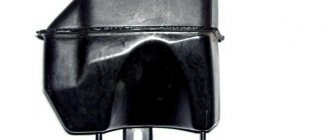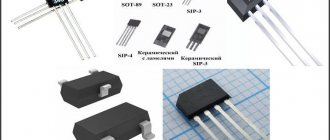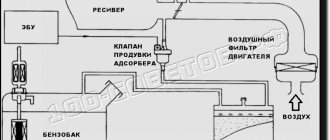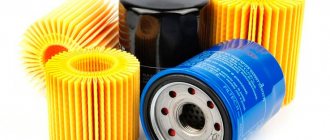When gasoline comes into contact with air, vapors are released, which, when released into the atmosphere, worsen the environment. To catch them, an adsorber is installed in the ventilation system of the gas tank. In a number of European countries, the use of this device in a car is mandatory at the legislative level and is determined by environmental standards Euro-2 and higher. Knowing the adsorber device and why it is needed, you can easily identify malfunctions, as well as better understand its benefits.
Purpose and principle of operation of the adsorber purge valve
Absorber valve diagram
The EVAP system is installed on gasoline internal combustion engines to prevent fuel vapors from entering the atmosphere. The canister purge solenoid valve is an element of this system. Therefore, to find out what the canister valve is for and how it works, it is important to understand the operating principle of the entire system. The design of the adsorber is a container filled with an adsorbent, most often activated carbon. The device is connected to the fuel tank and the control valve of the vehicle using special tubes.
The canister valve is installed between the intake manifold and the canister and performs the function of ventilation.
Gasoline vapors formed in the fuel tank penetrate the separator, where they condense and are discharged back into the tank. Some of the vapor does not have time to condense in the separator and enters the adsorber through the steam line. In the filter system, they are absorbed by activated carbon, accumulated and then supplied to the intake manifold when the engine starts. The process of absorption of fuel vapors takes place only when the engine is turned off. When the car is running, the electronic control unit opens the canister purge solenoid valve, through which air enters and thus ventilation occurs. In this case, the accumulated condensate along with air is sucked out of the adsorber and again enters the engine, where it is burned out. The canister valve provides ventilation to the entire mechanism and directs fuel condensate back to the engine.
How does a gasoline vapor adsorber work?
In the diagram: 1 - steam pipe; 2 — adsorber tube and purge valve; 3 - shalngi; 4 — purge valve; 5 — fuel drain pipe; 6 — fuel vapor separator; 7 — gravity valve; 8-10 — steam pipes; 11 - adsorber;
Structurally, the adsorber is a hollow cylinder filled with a filtering agent and equipped with a number of additional modules. Its main elements:
- directly container for the filter;
- activated carbon in the form of granules - this substance effectively traps gasoline fumes;
- separator - responsible for returning trapped vapors to the fuel tank;
- gravity valve - necessary in emergency situations, in particular during accidents, when there is a high risk of gasoline overflowing through the neck of the gas tank;
- solenoid valve - responsible for switching the operating modes of the adsorber;
- connecting tubes - combine all elements of the unit into a single system.
The key element of the system, in addition to the filter container itself, is the solenoid valve. It ensures not only switching the accumulation mode to the mode of transferring accumulated vapors to the fuel system, but is also responsible for ventilation of the entire system. Thanks to this part, the retained fuel moves, frees the adsorber cavity for a new cycle of work, and maintains the functionality of the system as a whole.
Checking the functionality of the adsorber
To make sure that the malfunction is related specifically to the valve of this element, you can send the car for a full diagnosis. But this is expensive, so let’s first try to identify possible problems ourselves.
First of all, you need to see if the controller is generating errors, for example, “open circuit control.” If everything is fine, then it will use a manual check. To do this, just prepare a multimeter, a screwdriver and several wires. After this you need to follow a few simple steps:
- Raise the hood of the car and find the valve you need.
- Disconnect the wiring harness from this element. To do this, you must first release the special lock that secures the pad.
- Check if there is voltage going to the valve. To do this, you need to turn on the multimeter and switch it to voltmeter mode. After this, the black probe of the device is connected to the ground of the car, and the red probe is connected to the connector marked “A”, which is located on the wiring harness. The next step is to start the engine and see what readings the device gives. The voltage should be the same as the battery. If it is not there at all or is too small, then you will probably have to look for a more serious problem. If everything is fine with the voltage, then you can move on to the next step.
- Remove the purge valve. To remove it you need to use a screwdriver to slightly loosen the clamps. After this, you can easily move the valve slightly up and smoothly pull it out along a small bracket. After this, the device must be connected directly to the battery terminals. One wire goes to the purge valve (to “+”), and the second is connected to “minus”. After this, both conductors are connected to the corresponding battery terminals. If there is no click, then the valve is completely out of order and it is best to replace it.
We recommend: How to restore and repair the heated rear window if it does not work
Installation
At this stage, the adsorber has been successfully dismantled. Now you can begin installing the new device. The longest piece of rubber hose is connected to the tube that supplies fuel vapor to the purge channel. The smaller part of the hose is connected to the intake pipe from the separator. After that we put it on the fastenings. Now we connect the vapor supply hose to the purge channel. The latter is installed on the motor cover. The block with wires is also connected here. A long hose must be installed between the purge valve and the adsorber. Let us remind you that all rubber tubes must be resistant to motor oil and gasoline. The old hose with the check valve tube is removed. A short piece of part is installed in its place. That's it, at this stage the adsorber has been successfully installed. As you can see, the installation of this device can be done without the help of specialists.
Finally, we note that many car owners install adsorbers from the younger model, Priora, on VAZs of the tenth family.
Absorber valve: what is it for and what does it affect?
The valves in the absorber are a technically simple device that operate differently depending on whether the engine is running or not. Like all valves, it must open and close.
When the absorber cavity is clogged or some other malfunction occurs, the valve malfunctions. With a faulty adsorber valve, serious vehicle damage can occur because pressure is not released from the fuel tank and the cavity is not purged.
Symptoms of Absorber Valve Problems
There are several signs and symptoms that can help identify the technical condition of the valve:
- The fuel gauge shows either a full tank or an empty one.
- After starting the engine, after 5-10 minutes the revolutions begin to fluctuate.
- At idle speed, when you press the pedal, the car begins to stall.
- The engine does not gain speed when driving. It takes a long time to accelerate.
- When opening the gas tank cap, a vacuum is felt and a whistle is heard.
- Increased fuel consumption.
- When it’s cold (when the engine is running but not yet warmed up), knocking noises from the absorber are heard, as if valves are knocking.
The cause of absorber failure is not always the valve. This may be severe contamination of the absorbent element, in this case coal. Gases should easily pass through the coal granules and condense there.
The valve is very cheap. Therefore, it is possible to change if signs of improper engine operation are detected. You can also replace the adsorber filter element with your own hands: disassemble it, pour out the old coal, pour in new coal in large granules.
How to change the valve?
So, let's get to work. First you need to de-energize the car, that is, remove the negative terminal from the battery. Next, disconnect the plug from the control panel.
To do this, in order to get to this part, we loosen the inlet pipe clamp a little. Having removed it from the mass air flow sensor, we move it to the side. Now, in order not to remove the mass air flow sensor itself, we slightly bend the valve mount for its smooth dismantling. The mounting offset is approximately 1 centimeter.
After this, you need to pull it up along the grooves. So this part can be removed very easily. But at this point the adsorber valve has not yet been dismantled. Next, we will need to disconnect several supply fittings on each side. One of them is quite easy to remove, but the second may cause problems. The fact is that the supply fitting is fixed with a special latch. To remove it, you need to recess the latch and pry off the plastic antennae (in this case, the fitting rises slightly upward).
At this stage, the adsorber valve has been successfully removed. Installing the new one is done in reverse order.
What is an adsorber and what is it for?
What does the adsorber look like?
The adsorption process is the absorption of gaseous media by bodies of solid or liquid consistency. Accordingly, the main task of the adsorber is to absorb gases, preventing them from entering the environment. However, these are not exhaust gases, but gasoline vapors emanating from the cavity of the fuel tank. When the car engine is running, the trapped vapors are transferred to the intake manifold; while parked, gasoline vapors are neutralized inside the adsorber.
Thus, the adsorber does not allow gasoline vapors to penetrate into the environment, which is required by modern environmental standards, and also does not allow them to enter the cabin. In addition, delaying, condensing vapors and returning gasoline back to the fuel system provides additional savings.
We recommend: High idle speed - what could be the reason?
It should also be noted that the function performed by the adsorber is complex ventilation of the fuel tank. When fuel is consumed, the freed space is filled with air, which is supplied through the adsorber. Here the air is filtered and dried, which has a positive effect on the operation of the engine as a whole.
The key basis for dividing adsorbers into separate classes is its filling. Currently the following options are used:
- granular adsorbent in a stationary state;
- granular adsorbent capable of moving in the cavity of the device;
- fine-grained filling with a boiling bottom layer.
Adsorbers with static coarse-grain filling show maximum efficiency. Its main advantage is protection from partial or complete loss of the active substance along with fuel vapors.
What is an adsorber and EVAP system
Many motorists call the device for absorbing fuel vapors an “absorber,” but this is incorrect, since the name “adsorber” comes from the Latin words “ad” (translated as “on”) and “sorbeo” (translated as “absorb”) , which together means “surface absorption” (accumulation on the surface). In turn, the absorber absorbs the entire volume and cannot be used in this case.
Diagram of the fuel vapor recovery system
Since the largest amount of vapor accumulates in the fuel tank, the adsorber is located not far from it. In fact, it is part of an entire gasoline vapor recovery system (EVAP). The latter consists of the following elements:
- Gasoline vapor separator.
- An adsorbent element is a container with an adsorbent substance.
- Ventilation valve.
- Canister purge solenoid valve (located between the canister and the intake manifold).
- Pipes and hoses for connection to the fuel tank, intake manifold and atmosphere.
In addition to the main elements, the EVAP system is part of the OBD-II on-board diagnostic system and includes a number of sensors (fuel evaporation, pressure) and an electronic control unit (ECU) that actuates the solenoid valve.
Let's get started
Let's start by dismantling the part.
First you need to free it from the fastening elements, then disconnect from it the hose that supplies gasoline vapor to the throttle, and the wires with the block. Next, the purge valve is dismantled. The fuel outlet hose from the separator is also disconnected. The bracket should be unscrewed and removed. This is not difficult to do, since it is secured with only three bolts.
Malfunctions of the adsorber valve and their elimination
Almost continuous operation of the fuel vapor absorption system canister can cause damage to the purge valve. A malfunction of the canister valve often leads to damage to the fuel pump. Due to poor ventilation of the adsorber, gasoline accumulates in the intake manifold, the engine loses power, and fuel consumption gradually increases. This may cause the engine to stop completely. The operation of the entire vehicle depends on how the adsorber valve works.
How to check the functionality of the canister purge valve?
Checking the absorber valve
In order to notice and correct problems in time, regular checks of the adsorber valve are necessary. In this case, a breakdown can be identified by certain indirect signs. When the engine is idling or in cold weather, the vapor absorption system makes characteristic sounds, like the canister valve clicking. Some people confuse this sound with a faulty timing belt, rollers or other parts. You can check this by sharply pressing the gas pedal. If the sound has not changed, it means the canister valve is clicking. Experts can explain what to do if the canister valve knocks too loudly. To do this, you need to tighten the adjusting screw, and first it is cleared of epoxy resin.
The absorber valve can be adjusted.
The screw turns approximately half a turn. If you tighten it too much, the controller will generate an error. This adjustment of the adsorber valve will make its operation softer and the knocking noise quieter. However, how to check the adsorber valve for damage? Valve failure can be determined using an error diagnostic system or mechanical testing. Electronic error codes are stored in the controller's memory and indicate electrical damage. To check the valve, it is recommended to pay attention to errors generated by the controller, such as “open circuit of the canister purge valve control circuit.” Signs by which a malfunction of the adsorber valve can be mechanically determined:
- The appearance of dips at idle speed of the engine.
- Very low engine thrust.
- There is no sound of valve operation when the engine is running.
- A hissing sound when the gas tank cap is opened indicates a vacuum in the system. This is a sure sign of a malfunction in the adsorber ventilation.
- The appearance of a fuel smell in the car interior. However, its appearance can also be caused by other reasons.
We recommend: What is the difference between an injector and a carburetor in a car?
Is it possible to remove
First of all, as we have already figured out, an adsorber in a car is needed for the vehicle to meet environmental standards. But for some car owners this parameter is not so important, so they consider this system useless in the car. Many people cite the reason for removing the adsorber valve as a deterioration in engine performance and an increase in its gluttony.
But the presence of a working system in a car does not in any way impair the performance of the power unit, and gasoline consumption does not increase because of it, because it cleans the vapors, returning fuel particles back to the tank. Of course, the adsorber will not add significant savings, but it certainly does not increase the gluttony of the engine.
If you remove the system, the motor will not break. In some cases (when the filter medium needs to be replaced), removing the adsorber even leads to more stable engine operation at idle speed. This procedure is carried out as follows. The adsorber can is removed. Instead, a fine fuel filter from a carburetor internal combustion engine is installed. The tube to which the valve is attached is closed. The control unit is reconfigured (how chip tuning is carried out is described in detail separately ) so that the engine error warning does not appear on the device.
The disadvantages of such a “modernization” of a car are:
- The smell of gasoline in the car;
- Light hydrocarbons do not remain in the filter element, but go directly into the atmosphere;
- In some cases, the smell of gasoline will be heard in the garage after the car has been idle for a long time.
The advantages of removal are:
- Additional space in the engine compartment. For example, it can be used to install a pre-heater if the machine is operated in northern latitudes;
- The engine will operate more stably at idle speed (the problem with floating idle speed may be due to a clogged filter or a poorly functioning valve);
- There is no need to spend money on purchasing a new solenoid valve or filter.
Of course, whether to remove the adsorber from your car or not is the decision of every car owner. Everyone decides for themselves what to compromise on. But in some cars, the absence of this system leads to a strong smell of gasoline in the cabin, and on long trips this can have a bad effect on the well-being of everyone in the car.
Solenoid valve malfunctions
If the adsorber is in uninterrupted mode almost all the time, the purge valve can easily stop functioning. This will damage the fuel pump. If the adsorber does not ventilate properly, gasoline will gradually accumulate in the intake manifold.
This leads to some rather unpleasant “symptoms”:
- At idle, so-called dips appear.
- Traction is impaired (it seems that the vehicle is constantly losing power).
- When the engine is running, the sounds of the valve operating are not heard.
- Fuel consumption increases noticeably.
- When opening the gas tank cap, a hissing and whistling sound is heard.
- The fuel tank sensor literally lives its own life (it can show that the gas tank is full, and a second later - that there is nothing in it).
- An unpleasant gasoline “aroma” appears in the car interior.
Sometimes the filter element, on the contrary, makes too loud sounds, which are also not the norm. To make sure that the cause is a faulty valve and not a timing belt, just press the gas sharply. If the sound effect remains the same, then most likely the problem is in the canister valve.
In this case, it is recommended to slightly tighten the adjusting screw of the device. However, you need to tighten it no more than half a turn. Holding too tightly will result in a controller error. If such manipulations do not help, then you need to conduct a more detailed diagnosis.
Removal and inspection
2. Having released the latch, disconnect the wiring harness block from the canister purge valve.
3. Connect the negative voltage probe (to the car body).
4. Turning on the ignition, use a voltmeter to measure the supply voltage at terminal A of the wiring harness block (the pins are marked on the block).
Comment. The voltage at the terminal must be at least 12 V. If the voltage does not flow to the block or it is less than 12 V, it means that the battery is discharged, the power circuit is faulty, or the ECU is faulty.
5. Use a Phillips screwdriver to loosen the clamp securing the hose to the canister purge valve.
6. Remove the hose from the valve nozzle.
Advice. If the hose on the nozzle is seated tightly and cannot be disconnected, then you can remove the valve from the adsorber and, by rotating the valve, remove the hose from it.
7. Using a screwdriver, remove the valve from the adsorber.
8. We apply 12 V voltage from the battery to the valve terminals (“+” to terminal A, “-” to terminal B).
Comment. When voltage is applied to the terminals, the valve should open with a characteristic click. The faulty valve must be replaced.
Automotive absorber design
In simple words, the absorber design is a plastic jar with a filled filter catching element. The best substance for trapping and neutralizing fuel vapors is activated carbon.
The adsorber consists of:
- Separator. The separator captures gasoline vapors and sends them back to the fuel tank.
- Gravity valve. The gravity valve protects against fuel overflow if the car overturns. The valve blocks the movement of fuel.
- Pressure meter. The pressure sensor performs an important function - it monitors the vapor pressure in the fuel tank. When the maximum permissible pressure in the tank is reached, the sensor opens and releases the pressure.
- Filter element (activated carbon). The filter element in a car absorber is carbon in large granules. Large granules allow vapor to pass through the layer of carbon powder and condense.
- Connecting tubes. Connecting tubes serve to connect all structural elements.
- Solenoid valve. The solenoid valve changes the fuel vapor recovery modes.











